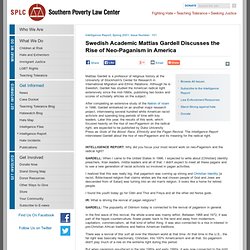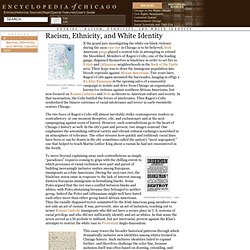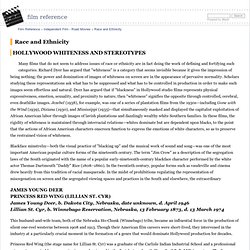

Race and Ethnicity within Asatru. The New Romantics. Mattias Gardell is a professor of religious history at the University of Stockholm's Center for Research in International Migration and Ethnic Relations.

Although he is Swedish, Gardell has studied the American radical right extensively since the mid-1990s, publishing two books and scores of scholarly articles on the subject. Shuttle ambivalently between whiteness and ethnicity. Tomorrow is Columbus Day in the United States. Like many other countries in "the Americas," we still mark this day, officially and otherwise. Celebrations of the efforts of Columbus usually erase the horrors of what he and his men did to indigenous peoples, thereby erasing as well the indigenous peoples themselves. Many people in the U.S. remember this childish mnemonic device: "In fourteen hundred and ninety-two, Columbus sailed the ocean blue.
" Far fewer have heard this worthy addition, by Historian James Loewen: "In fourteen hundred and ninety-three, Columbus stole all he could see. " Some white Americans, particularly those of Italian descent, remember Columbus differently, for their own ambivalent purposes. Christopher Columbus' first sighting of land that came to be known as "America" occurred on October 12, 1492. As a result of this later, secondary remembrance, conflict has arisen when other groups, especially Native Americans, began protesting this holiday. Article: America's Real Model Minority: It's white people, but d. Race critical theories: text and context.
Racism, Ethnicity, and White Identity. If the grand jury investigating the white-on-black violence during the 1919 race riot in Chicago is to be believed, Irish American gangs played a central role in attempting to extend the bloodshed.

Members of Ragen's Colts, one of the leading gangs, disguised themselves in blackface in order to set fire to Polish and Lithuanian neighborhoods in the Back of the Yards area. Their hope was to draw the immigrant population into bloody reprisals against African Americans. Two years later, Ragen's Colts again mounted the barricades, hanging in effigy a Ku Klux Klansman in the opening salvo of a successful campaign to isolate and drive from Chicago an organization known for violence against southern African Americans, but now focused on Roman Catholics and Jews as threats to American culture and society.
In that incarnation, the Colts battled the forces of intolerance. Hollywood whiteness and stereotypes - Race and Ethnicity. Many films that do not seem to address issues of race or ethnicity are in fact doing the work of defining and fortifying such categories.

Richard Dyer has argued that "whiteness" is a category that seems invisible because it gives the impression of being nothing; the power and domination of images of whiteness on screen are in the appearance of pervasive normality. Scholars studying these representations ask what has to be suppressed and what has to be controlled in production in order to make such images seem effortless and natural. Dyer has argued that if "blackness" in Hollywood studio films represents physical expressiveness, emotion, sexuality, and proximity to nature, then "whiteness" signifies the opposite through controlled, cerebral, even deathlike images.
Honorary whiteness - Asian Ethnicity. Shades of Difference: A History of Ethnicity in America (Perspec. Race critical theories: text and context. Rewriting the discourse of racial identity : Towards a pedagogy. Titre du document / Document title Auteur(s) / Author(s) Affiliation(s) du ou des auteurs / Author(s) Affiliation(s) (1) Pennsylvania State University, ETATS-UNIS Résumé / Abstract In this article, Henry Giroux places the study of Whiteness in a historical context, recognizing the various modes in which racial identity has been used by conservative ideologues and critical scholars who seek to expand the discussion of race and power.

Revue / Journal Title Source / Source CongrèsEthnicity and Education Forum: What Difference Does Difference Make ? Langue / Language Anglais Editeur / Publisher Harvard University, Cambridge, MA, ETATS-UNIS (1937) (Revue) Mots-clés anglais / English Keywords Sociology of Education History Ethnic Group Cultural Identity Race Relations Ideology Power Social Inequality Racism Democracy Human Rights Racial Discrimination Mots-clés français / French Keywords Sociologie de l'éducation Histoire Etats-Unis Groupe ethnique. Bleach in the Rainbow: Latin Ethnicity and Preference for Whiten.
GRAND OL' PAGAN: What Does the Republican 'Heathen' Running for. Conservative.

Republican. Pagan? It was an odd news story that briefly upended what should have been a sleepy City Council race in Bayside: the Queens Tribune reported that a conservative Republican was running a strong race in the 19th district and had a chance to win in the overwhelmingly Democratic city. But this was a conservative Republican with a difference: Dan Halloran is the spiritual leader of a local pagan group that worships Norse gods.
Although the Tribune's story had no hint of derision for Halloran's religious affiliation, the newspaper was immediately attacked for its perceived ties to Halloran's Democratic opponent. But Halloran's beliefs are newsworthy. In fact, Halloran and his fellow travelers are more properly thought of as "heathens," not pagans, and the tribal customs they ascribe to are heavy on hierarchy and tradition. As the Tribune first pointed out, Halloran is "First Atheling," or prince, of a Germanic neo-heathenist "theod" or tribe. Alternative Right. The Separation of Race and State?